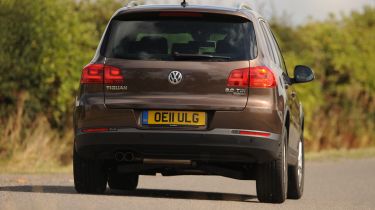Used Volkswagen Tiguan (Mk1, 2008-2016) - What’s it like to drive?
It’s a little less comfortable than some rival SUVs, but it’s also better to drive. The diesel engines deliver excellent fuel economy
The Volkswagen Tiguan comes in four-wheel and front-wheel drive versions, both being comfortable and enjoyable to drive. Thanks to great adjustability in the driver's seat and steering wheel, visibility is great and it's easy to find the ideal driving position.
Engines
The Tiguan arrived in February 2008 with a choice of two engines: a 1.4-litre TSI petrol producing 148bhp and a 2.0-litre TDI diesel producing 138bhp. A 168bhp version of the 2.0 TDI arrived in April 2008, before a pair of 2.0-litre TSI petrol engines arrived in autumn 2008. These produced 168bhp or 198bhp. An eco-focused 108bhp 2.0-litre TDI arrived as part of the facelift in 2011.
There was also a 181bhp version of the diesel engine, but this was dropped towards the end of the Tiguan’s life. Available exclusively with four-wheel drive, the most powerful diesel could complete the 0-62mph time in just 8.3 seconds.
Thanks to their blend of fuel economy, refinement and pulling power, the diesel-powered Tiguans were more popular than the petrol versions. The 108bhp diesel is too slow, with the 0-62mph sprint turning into an 11.9-second crawl. The 148bhp version completes the sprint in 9.8 seconds.
Relatively few petrol versions were sold – the Mk1 Tiguan stems from a time before the Dieselgate scandal – but they’re worth a look if you spend most of your time in the city. Take the 1.4 TSI, which uses a supercharger and a turbocharger to great effect, delivering a great balance of performance and economy. A 0-62mph time of 9.6 seconds is adequate for a car of this size.
The 2.0 TSI engines are harder to recommend, although it’s worth noting that the 198bhp version is lifted from the Volkswagen Golf GTI hot hatch. This model will sprint to 62mph in 7.9 seconds, but the penalty is poor fuel economy.
On the road
Like most SUVs of this size, the tall dimensions can mean that the Tiguan feels a bit unwieldy through corners, but the Golf underpinnings mean that it’s pretty good to drive. The suspension is a little firm, but this delivers more composed handling and a little more fun behind the wheel.
Volkswagen’s 4Motion four-wheel drive system was fitted as standard to all Tiguans at launch, with front-wheel-drive versions arriving later in 2008. It’s not really designed for serious off-roading; it’s more about providing reassurance on slippery roads and during winter driving. However, grip on the front-wheel-drive Tiguan is so good, you probably won’t need four-wheel drive and the extra thirst it brings with it.
Overall, it’s just a very easy car to drive. The high driving position provides a commanding view of the road ahead, and the steering is adjustable for height and reach on all models, so you’ll have no problem finding a good driving position.







